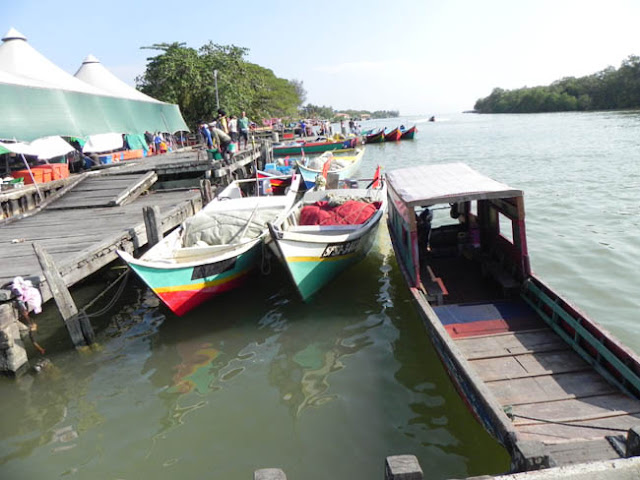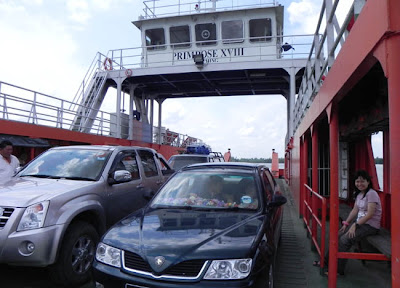Mukah was the last stop for our roadtrip starting from Sibu. We were off from Dalat around 5:45 pm, and took 35 minutes to cover 35 km of journey.
Mukah is a town where the town's border is drawn along the seashore and Mukah river. Mukah has a humble start as a small fishing village, which then served as an outpost for the sultanate of Brunei. It is not a big town yet, but the development is vast. The reason- it is a part of SCORE (Sarawak Corridor of Renewable Energy).
The attraction of Mukah is at it's old town area, where the nice seafood restaurants, kopitiam, fish market, local market, and many of the hotels are gathered within walking distance (20 minutes the most from each others). With two markets located side by side, harbour for fisherman and the stalls for the local delicacies and eateries all clustered together, the old town area is somewhere that you should not miss. Fish sold at Mukah Fish Market are fresh, and what we should not miss- the fish for umai. Umai is a traditional Melanau dish where fresh fish is sliced and mixed with lime, onion, and a little bit of chili (chili is optional).
After a night stay at Kingwood Hotel, we took our breakfast at the eateries beside the fish market. Then, we moved around the markets for about an hour, and carried away some fresh fish, sliced fish for umai, some tebaloi (traditional sago biscuit), and a terap (local fruit).
The last wooden shops in old town area. The rest, ash to ash, dust to dust, due to the fire outbreaks.
The old town area.
Unlike the mysterious Labuan Chimney, this Mukah's chimney served as a part of sago production factory, which once generated handsome revenue for the local Melanau chieftains. However, as the price of the sago powder dropped sharply, the factory was abandoned, so did the chimney. The chimney can be seen at the old town, beside Mukah River.
The fish at the market is supplied by the small fishing boat, which will return a few times a day to unload the catch (9 am, 12 pm, and 4 pm, if not mistaken). The harbour is just right outside of the market. So, if you want to get a fresher fish, you need to go and catch it by youself :)
Two fishing boats are approaching the harbour, with some of the fish vendors awaiting at the harbour for possible deals.
We can see the village opposite of Mukah River. Small motorboats are the main commuters for the villagers.
Mukah fish market might be smaller than many other fish markets. But, when we talk about fish business, the freshness, which Mukah fish market outmatched the rest, counts.
These are the creatures that swam in the sea few hours ago...
Mukah's local market is the place that we can find many local products, with local price. The market is located adjacent to the fish market.
Giant banana that can fill up a meal (upper left) and exotic sago worms sold with RM 5 per small basket (upper right). Buah terap is authentic Borneon fruit. We never thought we could find one in Mukah as the fruit is rarely found nowadays.
Small stalls selling local sago products, cakes, snacks, and other dried seafood products are available beside the local market. Tebaloi, the well-known Mukah's keropok ikan and keropok udang are something that you should try.
Black Liberica coffee, tea, panggang (coal roasted glutinous rice), you-tiao, and fresh buns made a perfect breakfast at Mukah. The eateries are located just beside the fish market.
A scene at the eateries for breakfast. We can see the fish market on the left, outside of the eateries.
The new township of Mukah with many modern concrete buildings. The district office of Mukah can be seen at far left. Many fast food chains and supermarkets are available in the new town area (which were not our interest).
Another scene at the new town area. The old town buildings can be seen on the far left.
The mosque with the domes with the motif of Melanau's hat is a symbolic of the dominancy of the Melanau ethnic resides in this area. Other ethnics are Chinese, Iban and Malay.
Trees are well blended into the landscape of the new town area.
Kingwood Hotel is the place that we stayed. The three star hotel is clean, well maintained, and has a good location at the middle of the town. The restaurant was empty due to the Ramadhan month (lower left). We were charged RM 88 per night for the twin bed room with aircond and flat screen (lower right).
On our way back to Sibu, we stop by Kingwood Resort Mukah for a while. The resort located 15 minutes away from the town area, which for us, is the down side. However, the hotel might be a good place for a retreat as it is just by the sea with very nice and quiet surrounding.
Almost forgotten to mention the seafood at Mukah. The price for the seafood is really cheap. We got the deal of RM 18 for 1 kg of crab and RM 10 for a whole full plate of umai for our dinner on our first night at Mukah. The restaurant, Medan Seafood, is just around 200 meters away from our hotel (same row with Kingwood Hotel). Our way back to Sibu took us almost 2 hours with 180 km. The route- the one that had been indicated in Google Map.
These are some of the Hotels in Mukah town area:
-Kingwood Hotel, Mukah (middle of the town, opposite of the mosque)
-Kingwood Hotel, Mukah (middle of the town, opposite of the mosque)
Tel: +6084-87 4996; Rate: Can be as low as RM 88 at non-peak season.
-King Ing Hotel (Old town area, quite isolated at the side of the river)
-King Ing Hotel (Old town area, quite isolated at the side of the river)
Tel: +6084-871403; Rate: Starting from RM65.
-Golden Inn (Same row with Kingwood Hotel)
-Golden Inn (Same row with Kingwood Hotel)
-Hotel Seri Umpang (Old town area, opposite of the markets)
Tel: +6084-87 1888; Rate: Call to confirm.
-Mandarin Hotel (Old town area, opposite of the markets)
-Mandarin Hotel (Old town area, opposite of the markets)
Tel: +6084-872688; Rate: Starting from RM 45
-Kingwood Resort, Mukah is a little bit isolated. But it won't be a problem if you have your own transport.
Tel: +6084-87 4996; Rate: Can be as low as RM 129 at non-peak season.
Mukah is now inter-connected with the major cities of Sarawak with public transportations, such as commuter buses and airplane.
What to expect in Mukah?
- Mukah fish market and local market at old town area.
- Fresh fish, fruits, sago worm, terap, and other local products.
- Nice and cheap seafood at seafood restaurant.
Take a look on our sharing about other places in Sarawak:



















































